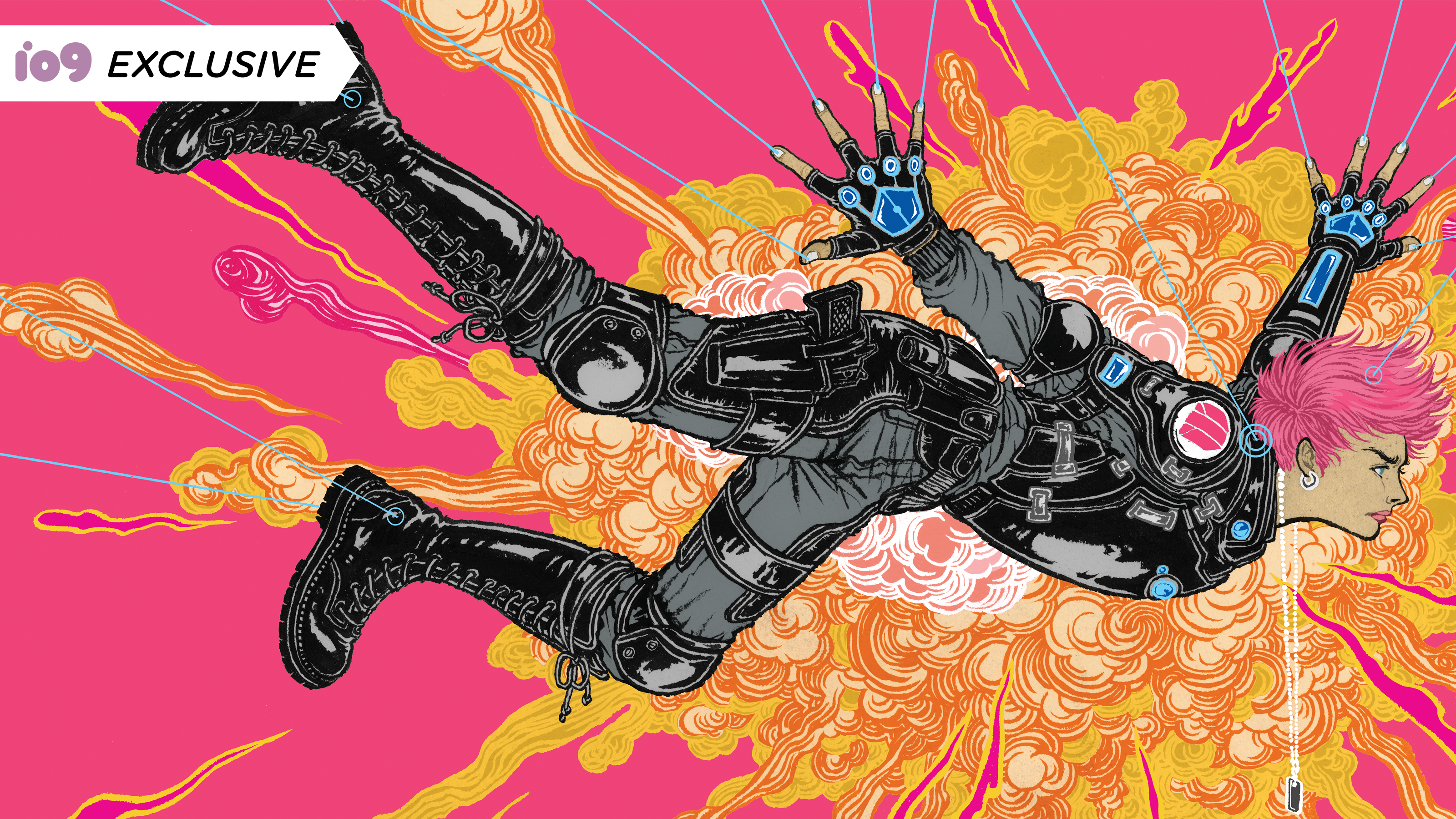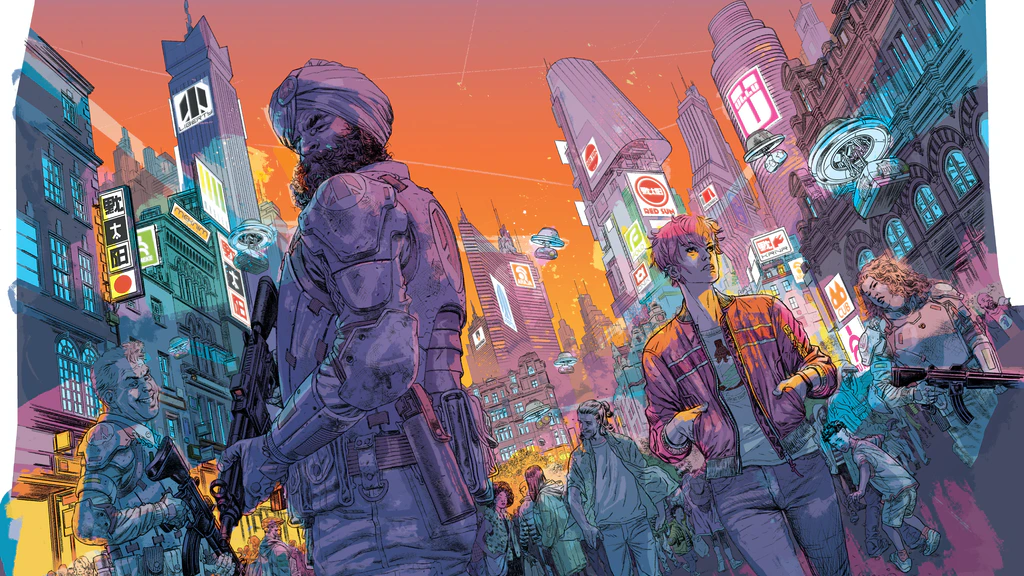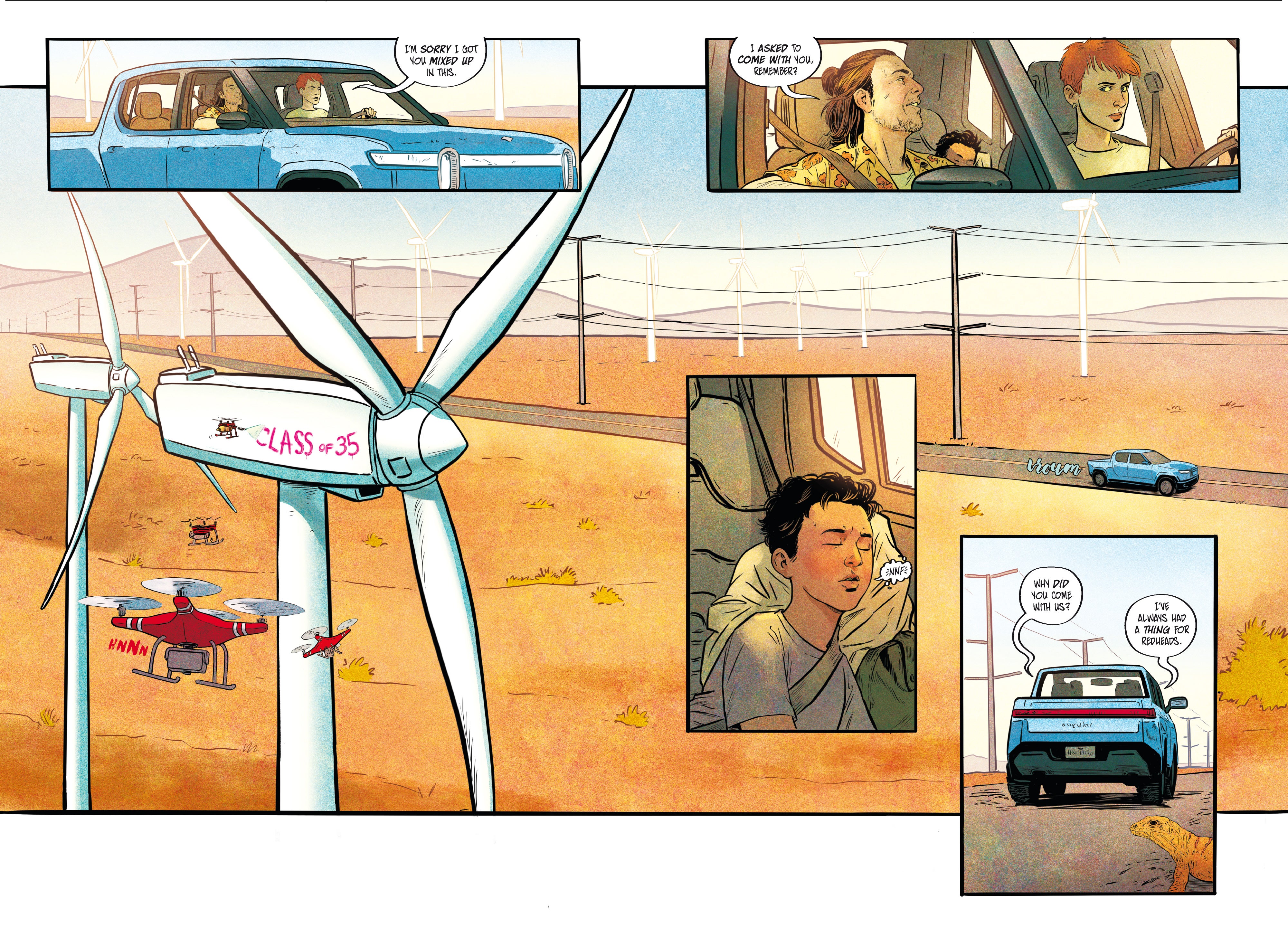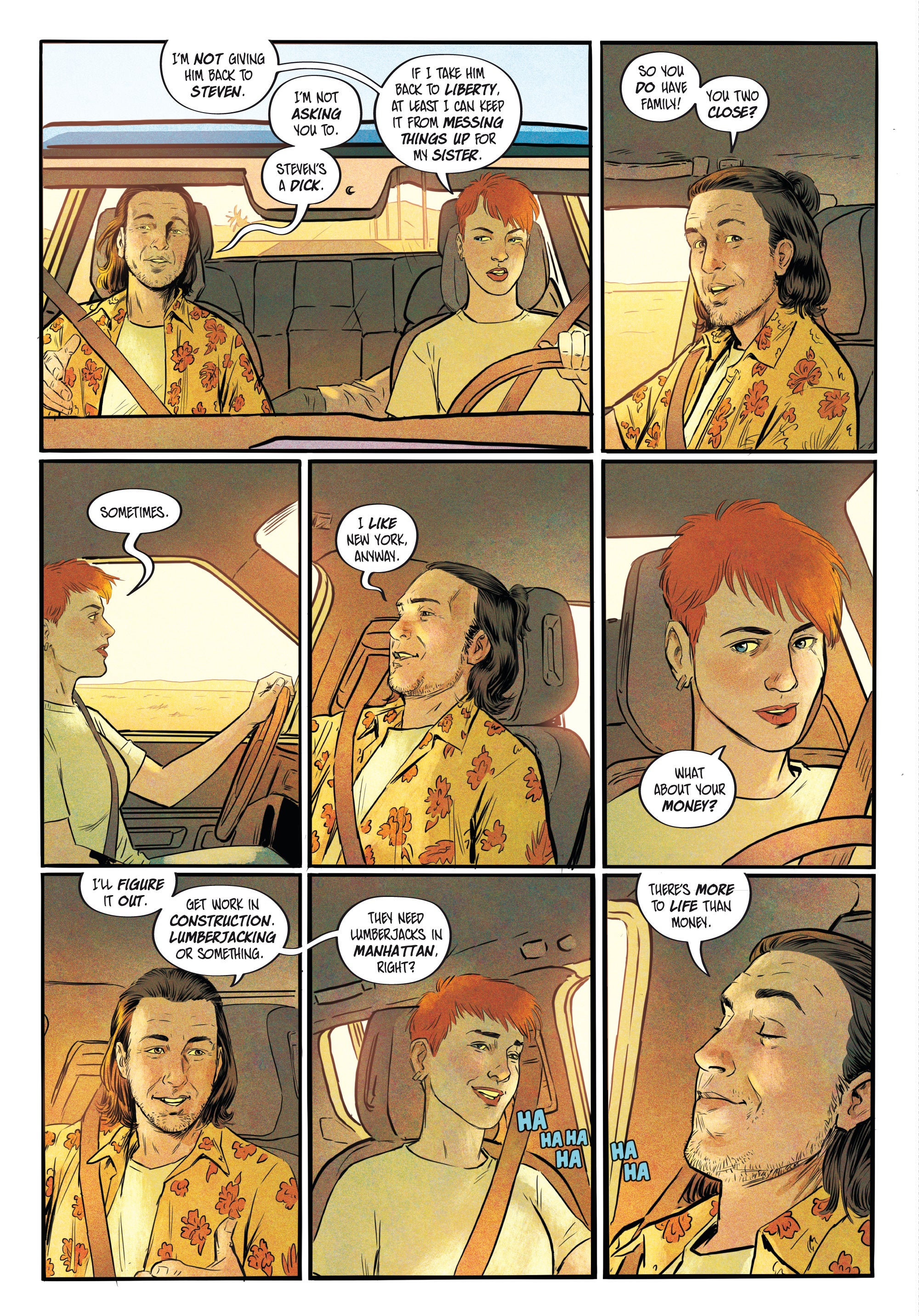Duncan Jones And Alex De Campi On Why Comics Was The Next Place For Moon And Mute's World To Go
by James Whitbrook
Between taking us to Azeroth and trapping us in time loops, director Duncan Jones has crafted a sci-fi universe of his own making in little ways, through his work in his directorial debut, Moon and its spiritual successor, Mute. Now, that world is getting another addition: but it’s not on the big screen. It’s in the pages of a comic book.
After writing a screenplay for a potential third entry into this subtly connected universe, Jones realised his vision for the Mooniverse would require a much grander budget that he’d initially imagined. And so, almost a year ago, he took to Twitter and posed a simple question to his 350,000 followers: did they know a bunch of comics artists who might want to help him turn it into a comic book instead?
Jones’ tweets put him on a path to Twisted Fantasy’s Alex de Campi. And from there, their plans grew together beyond Jones’ original idea to craft a commissioned pitch to instead create Madi: Once Upon a Future, a 260-page graphic novel based on Jones’ script—brought to life not by a handful of artists, but a legion: 17 artists, nine colorists, and lettering by de Campi herself, split off into different creative teams to each tackle a particular section of Madi and bring Jones’ “Mooniverse” to the page. Why so many? Because Madi is a sci-fi, globetrotting road trip.

Set in the same sci-fi future that Moon and Mute share in the backgrounds of their individual, independent stories, Madi follows the titular heroine—Madi Preston, a former SpecOps soldier riddled by debts racked up paying off the cybernetic implants given to her during service. Turning to mercenary work that only amplified her woes, Madi decides enough is enough, going on one last mission-for-hire to steal a piece of technology that could guarantee a free life for her and her sister. But when the piece of tech turns out to be way more than she bargained for, Madi finds herself on the run from friends and former foes alike, with a new quarry to deal with.
It marks another big sea change in Jones’ oeuvre, already having made the jump to streaming platforms to bring Mute to life on Netflix. Not only is he working in a medium he’s never worked in before—although now he’s also doing it the other way around, on a film adaptation of 2000AD’s Rogue Trooper—he’s releasing the fruits of his, de Campi’s, and dozens of artists and colorist’s labours in a relatively unique way. Madi won’t hit comic book store shelves, global pandemic or otherwise; it’s only available in physical form, and only through Kickstarter. Where, as of writing, it has made over a quarter of a million dollars in a week, smashing its goals
To find out more about why Jones chose comics for his next story, and why de Campi helped bring that decision to life, Gizmodo recently chatted with the duo over email. Check out our interview below—as well as an exclusive look inside a section of Madi illustrated and coloured by Pia Guerra and Matt Wilson, with lettering from de Campi!
Gizmodo: Looking back when plans for Madi started coming together, did you think you’d reach your goals this quickly?
Alex de Campi: No, clearly not. I was the noisy annoying one who was like “Let’s do a Kickstarter!” And in my Pollyanna-like state I was just thinking it will help raise the book’s profile/let us engage with fans and maybe we’ll be able to foot our print bill in advance. But I think the current situation has helped us tremendously, in a weird way: we’ve got a big, exciting book you can pre-order and get involved in, at a time when book and comic shops are closed and no other books are coming out.
Gizmodo: For those unfamiliar with this shared universe, what can you tell us about Madi’s story, and its lighter connections to Moon and Mute?
de Campi: I’ll let Duncan talk plot and the stories’ shared universe, but thematically the stories are linked by messy, unready people having to suddenly become responsible both for determining their own future and also the future of someone newly dependent on them. Sam Bell, Leo, and Madi are all just kind of existing at the beginning of their stories, doing jobs they’re good at but not really going anywhere. And each story then basically hits them with a metaphysics truck, reverses back over them, drops off an unexpected passenger, and says “now what.”
Duncan Jones: I think Alex sums it up perfectly here. All three stories are about imperfect people trying to deal with unexpected new responsibilities. As universal, and as human a theme as you can hope for. I think that’s a feeling that just about everyone can empathise with. It’s pretty much the definition of “growing up.”
Gizmodo: It’s been a while since Duncan first started looking for comics creatives on social media for this venture. Alex, can you tell us a little bit about how you came to join Madi, and what it was about the project that intrigued you in the first place?
de Campi: I’m fundamentally a character writer so when I see someone else doing these clever, minimalist character stories in what tends to be a maximalist, world-first, character-second medium like sci-fi I’m like “OK, I want to get involved in that.” Duncan is a world-class character writer, let me tell you. His people are messy and nuanced and come across as fully realised humans. And, look, I have a lot of my own books. I have places to go solo or in close collaboration with artists. Alongside that I really enjoy producing, and becoming invisible in someone else’s vision. This is the sort of project where I can just check my ego at the door and have a ton of fun building out the best version of Duncan’s story that I can.




Gizmodo: Alex, you’re primarily known for your comics work, but you’ve also dabbled in screenwriting for things like the upcoming Blade Runner anime. What was it like for you to approach the screenplay version of Madi as a potential film project, and translate it into a comics script?
de Campi: A story’s a story, man. Those of us that make things, there’s a lot more flow between different formats for us than it seems from the outside. Screenplays are fun for me to adapt because I can print them out, take them outside to the park or the beach and hand-write my comic script breakdowns on the left/facing pages, which is exactly what I did with Madi. I even have photos of it, if you want to see what my terrible, terrible handwriting looks like. Right after Madi, I adapted my own Bad Karma (which was written screenplay-first for Blade Runner-related reasons) back to comic script the exact same way.
Gizmodo: Duncan, obviously your Moon trilogy/shared universe has existed in a very different form up to this point. Why did you decide to go the comics route for this addition to its universe?
Jones: Practically speaking, independent movies are hard enough to finance at even a modest budget. Make it female-led, non-IP, and the higher end of the budget spectrum and you are giving yourself a mountain to climb. But I could not let it go. It’s too good! An intensely interesting story with a unique sci-fi premise and non-stop action! I had to find a way to give it life and for the sheer scale of the world-building involved, comics really became the perfect medium.
Gizmodo: One of the most intriguing things about this project is that you’re both working with a very large team of artists to tell a single narrative. Can you both tell me a little about why you decided to take this approach instead of working with a single artist/colorist team? What was most important to you both that Madi have a varied aesthetic that comes from the input of all these artists’ involvements?
de Campi: I think honestly what was most important to us was turning the book around in under five years. To find one artist of the calibre we wanted to draw the whole thing, we would have had to wait probably a year or more for a space in their schedule, and maybe two years for them to draw all of it. By parceling the book out among different artists in shorter amounts, we could work with better-quality artists who had a little time in their schedule but not a whole book’s worth, get the book out faster, and do something fun and innovative. Duncan’s story and my adaptation (really, *our* adaptation, it was a collaborative Google doc) very much suits a multi-artist approach.
Gizmodo: Alex, you’ve experienced working with different creative teams before across your comics work of course, but what’s it been like collaborating with so many artists on a single project like this, on top of working with Duncan as well?
de Campi: You know, I did all this already in my book Ashes, and then in Twisted Romance where I was putting out a 48-page anthology book *weekly*. And I’m doing it again at the same time in my current book True War Stories, that I’m creating at the same time as Madi. It’s just project management, and I’m detail-oriented and very organised so it’s fine. Some days it’s overwhelming, when a whole bunch of stuff comes in for True War and Madi at the same time, but you get through it. We have a great structure of shared Dropbox folders and Google docs, and I really stay on top of contracting and managing invoices (the fastest way to a freelancer’s heart is to pay them fairly and quickly.)
And let’s face it, I know most of these artists. We’re friends. I was just emailing with Tonci Zonjic on backgrounds and reference and then we digressed onto pizza recipes. Duncan and I are just hanging out, making a book in a very relaxed (yet organised) way with our friends. There’s a good and happy atmosphere/culture around the book, and that’s very deliberate on Duncan and my part.
Gizmodo: This has been pitched as the “final” entry in a trilogy of connections between Moon and Mute, even if all these stories are relatively standalone from each other. Duncan, do you have plans for more stories in this universe beyond this, and do you think you’d be sticking to comics for them or considering other mediums beyond films?
Jones: Well I would absolutely dip my toe into doing something in video games, if I can find the right fit. I have history there, having worked at a games company a long, long time ago, (and obviously anyone who knows me, knows I like to indulge in the hobby!) It would be amazing to shape the world from Madi and the films into a place players could actually explore a bit! We’ll see...
Gizmodo: Another thing I wanted to ask was as to why you’ve specifically ruled out a digital version of Madi for now. Considering that this shared universe of tales has been born across several mediums already—film, streaming platforms, and now comics—Why was it important to you both that, for the foreseeable future, this story is only told in a physical format?
de Campi: You’ll never please all the nerds all of the time so we don’t try. The Kickstarter is about this gorgeous, oversize graphic novel as an object, and allowing people to get wrapped up in the art at the size it was made, rather than squinting at it on a phone. And yes, I realise I completely sound like Quentin Tarantino banging on about 35mm and cinematic projection right now but you know what? He’s not wrong. Later on, when the paperback version is in stores, we’ll probably put a digital version out through iBooks, but not now. We don’t need to.
Madi: Once Upon a Time in the Future’s Kickstarter will run until June 30. If you want to back your own copy, you can check out the full list of backer tiers here.